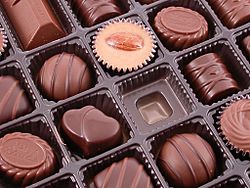Bonbon facts for kids

Box of bonbons
|
|
| Alternative names | Bon-bon |
|---|---|
| Type | Confectionery |
| Place of origin | France |
A bonbon is a small, delicious chocolate candy. These yummy treats often have a sweet filling inside, and they are usually wrapped in colorful foil.
What's Inside a Bonbon?
Bonbons are small candies, but their ingredients, flavors, and shapes can be different depending on where you are in the world. In France, for example, bonbons might have a fruity center. They can also be filled with crunchy brittle, chewy nougat, or smooth caramel.
Other popular fillings for bonbons include:
- butterscotch
- fondant (a soft, creamy candy)
- fudge
- ganache (a rich chocolate cream)
- gianduja (a hazelnut chocolate paste)
- marzipan (an almond paste)
- praline (a nutty caramel)
- truffle (a rich chocolate ball)
In France, there are special rules for what can be called a "bonbon de chocolat." It must be at least 25% chocolate! It can be:
- a small, bite-sized chocolate.
- a mix of different chocolates.
- a combination of chocolate and other yummy ingredients.
In the United States, the name "Bon Bon" is also used for a special frozen treat. It's a trademarked name by The Hershey Company for a small ball of vanilla ice cream covered in chocolate.
Where Did the Name "Bonbon" Come From?
The word "bonbon" comes from the French word bon, which means "good." It's like saying "good-good"! This sweet name started in the 1600s in the French royal court. From there, it spread to other countries in Europe by the 1700s.
Bonbons became popular gifts, especially during holidays like New Year's Day. They were often given in fancy, decorated containers.
A famous composer named Johann Strauss II even wrote a waltz called Wiener Bonbons in 1866. The music's title page shows the name written to look like twisted bonbon wrappers!
See also
 In Spanish: Bombón (chocolate) para niños
In Spanish: Bombón (chocolate) para niños

